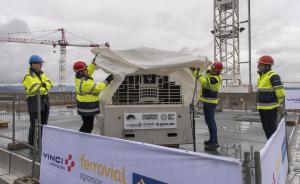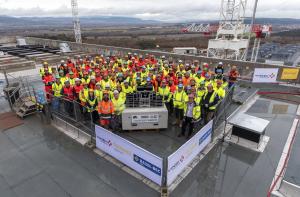Une « formidable aventure » s'achève
Cette structure de cinq étages est un bâtiment nucléaire, avec des armatures d'acier exceptionnellement denses dans certaines zones. Il compte aussi un grand nombre de pièces, avec pas moins de 300 caissons répartis entre les différents niveaux.
« Comme toujours avec ITER, les choses n'ont pas été simples, plaisante Romaric Darbour, et notre chemin a été semé d'embûches. Mais, au fil de ces 14 années, nous avons développé des compétences qui se révèleront précieuses pour la construction des futures centrales de fusion. » Pour Jérôme Laclau, le directeur France de Vinci Construction Grands Projets, la première de ces compétences était de parvenir à « constituer une équipe de projet » capable de relever les défis d'un projet de construction sans précédent et de le livrer « dans les délais, voire même avec un peu d'avance. »
Les entreprises du consortium VFR (Vinci, Ferrovialet Razel-Bec) « ont mobilisé le meilleur de leur savoir-faire », explique Jérôme Laclau. Aurélien Gayrard-Bouzereau, directeur de projet chez VFR, souligne le rôle central des ouvriers, « qui ont travaillé sous le soleil et sous la pluie, par 5 degrés au-dessous de zéro et sous un soleil de plomb, à des températures qui peuvent atteindre 40 degrés en Provence ».
Trop lourd pour être utilisé comme serre-livre sur les étagères de Romaric Darbour, ce cadeau tout de béton et d'acier rejoindra probablement un autre symbole de l'avancement du chantier, l'olivier qui est resté quelques jours sur le toit du Bâtiment tokamak en 2019 avant d'être replanté à l'entrée du siège d'ITER.



